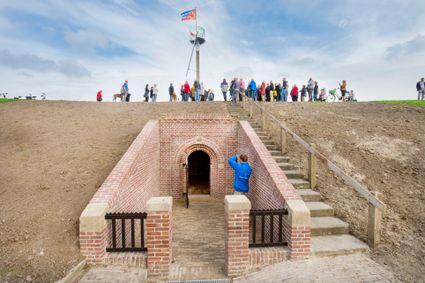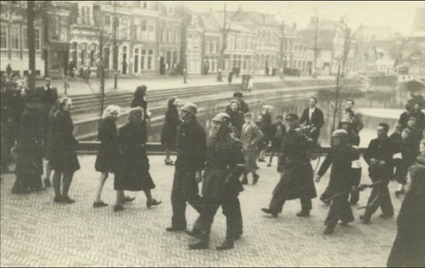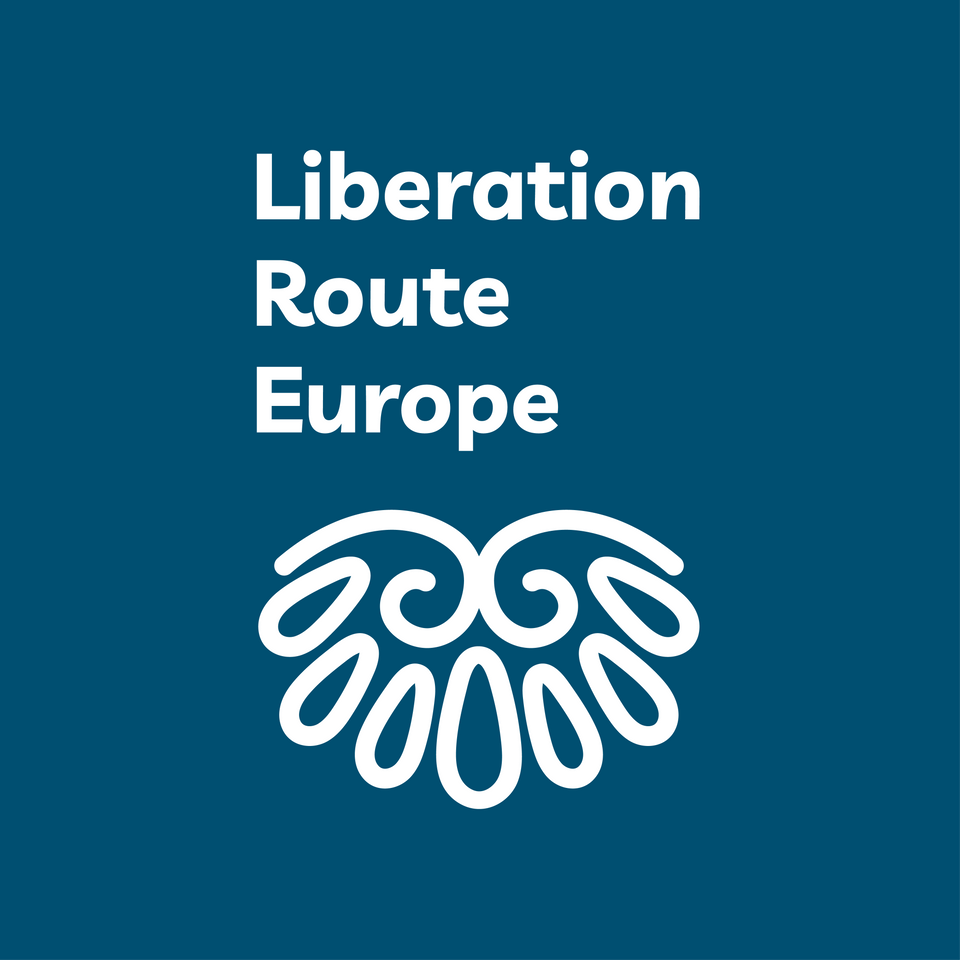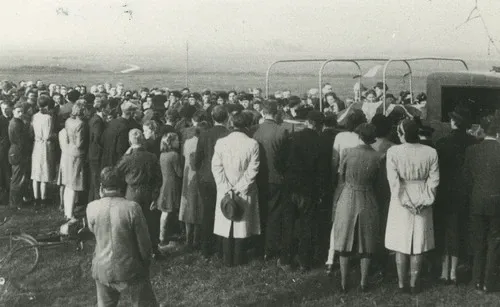Dokkum-Lauwersoog | Liberation route: section 7
The liberation of northeast Friesland was not achieved without a struggle. The Dutch Domestic Armed Forces (NBS) and Canadian troops fought fierce battles, partly side by side. At least six men lost their lives. It was mainly fleeing occupiers who caused fights and shootings that claimed lives on both sides. One escape route ran via Dokkumer Nieuwe Zijlen.
On Friday afternoon, 13 April 1945, the Leeuwarden headquarters of the resistance received the order to act openly against the enemy. Over the course of the evening, the five NBS groups of the municipality of Kollumerland-Nieuwkruisland gathered under the leadership of Municipal Operation Leader (Gemol) Ganzinga on Piebe Bakker's farm. Weapons and ammunition had been distributed, and they were ordered to take the locks of Dokkumer Nieuwe Zijlen. A detachment of Germans kept this entrance to the Wadden Sea well occupied during the war.
Th…
The liberation of northeast Friesland was not achieved without a struggle. The Dutch Domestic Armed Forces (NBS) and Canadian troops fought fierce battles, partly side by side. At least six men lost their lives. It was mainly fleeing occupiers who caused fights and shootings that claimed lives on both sides. One escape route ran via Dokkumer Nieuwe Zijlen.
On Friday afternoon, 13 April 1945, the Leeuwarden headquarters of the resistance received the order to act openly against the enemy. Over the course of the evening, the five NBS groups of the municipality of Kollumerland-Nieuwkruisland gathered under the leadership of Municipal Operation Leader (Gemol) Ganzinga on Piebe Bakker's farm. Weapons and ammunition had been distributed, and they were ordered to take the locks of Dokkumer Nieuwe Zijlen. A detachment of Germans kept this entrance to the Wadden Sea well occupied during the war.
The Wadden Sea and Lauwerszee area was of strategic importance. It was part of the German defence line, the Atlantic Wall. This bulwark ran along the coasts of France to Norway. At that time, the Lauwerszee was not yet closed off from the Wadden Sea, and the locks of Dokkumer Nieuwe Zijlen gave direct access to the sea and the Wadden Islands.
At night, the battle groups advanced on the locks. A number of men crossed the water to attack from the other bank as well. Things went wrong when a shot was fired too early and the Germans were alerted. Shots were fired from all sides, forcing the battle groups to retreat. Meanwhile, the Germans left their positions, and the next morning the Dutch flag was hoisted on the locks without a fight.
Part of the battle groups then took up positions at a crossroads not far from the locks. These were the roads along which the fleeing enemy tried to escape. In the course of Saturday morning, the first exchanges of fire already took place and the first arrests were made. In the days that followed, more and more occupiers tried to escape from Groningen to the West. The road to Germany was cut off. Motorcycles, buses and trucks passed the crossroads at the Soensterdijk. There were four fatalities on the side of the NBS in three days. The number of casualties (approx. 23) and prisoners (approx. 175) among Landwachters and Germans was considerably higher.
On Sunday, the fighting was so heavy that Canadian carriers were called in for help. From Dokkum, which had been liberated the evening before, the armoured vehicles came to the locks via Kollum during the morning to offer help. The fight was soon over, and dozens of prisoners were transferred from the locks to Kollum in the afternoon.
During the following days, several NBS members left the locks for nearby Oostmahorn to defend the port together with the Canadians against the attack of the German occupying forces from the island of Schiermonnikoog.
In 1950, a monument was erected on the Soensterdijk in memory of the NBS members who died and the resistance. Every year, the fallen are commemorated here.
Liberation Route Europe is a transnational memorial. A route that connects memorial sites and stories from all over Europe. For more information, visit www.liberationroute.com
Sights on this route
Starting point:
Waypoint walk 63
Dokkum
Navigate to starting point
Waypoint walk 63
Dokkum
Navigate to starting point
Oostmahorn (De Skâns)
Oostmahorn is pas sinds 2006 een dorp. Daarvoor was het een buurtschap onder Anjum, maar de plaats werd steeds omvangrijker door de komst van een aantal recreatieparken. Het inwoneraantal bleef echter rond de 80 steken.

Attack on the port of Oostmahorn
The liberation of the north-eastern part of Friesland was not achieved without a struggle. The Dutch Domestic Armed Forces (NBS) and Canadian troops fought fierce battles, partly side by side.
Attack on the port of Oostmahorn
The liberation of the north-eastern part of Friesland was not achieved without a struggle. The Dutch Domestic Armed Forces (NBS) and Canadian troops fought fierce battles, partly side by side. It was mainly occupiers fleeing in panic who caused fights and shootings that claimed victims on both sides. A fierce battle was also fought over the port of Oostmahorn.
After the liberation of Dokkum, Kollum and Dokkumer Nieuwe Zijlen, the attention of the Canadian troops turned to the port of Oostmahorn. It was the gateway to the island of Schiermonnikoog, which was part of the German defence line, the Atlantic Wall. This bulwark ran along the coasts of France to Norway. During the war, and extensive occupying force was stationed on the Wadden Island.
The village of Oostmahorn was "relieved" by the Dutch Domestic Armed Forces (NBS) on Saturday, 14 April, after the German Grenzschutz (border control) left in silence for Schiermonnikoog. Meanwhile, a group of more than a hundred fleeing SS and SD men and a dozen women crossed the Lauwerszee from Groningen near Zoutkamp with three boats to the island. A number of them were high-ranking SD members of the infamous Scholtenhuis in Groningen. When the NBS saw them sailing past from the port of Oostmahorn, shots were fired back and forth.
The German occupying forces on Schiermonnikoog then wanted to take revenge. The village and the port of Oostmahorn were attacked from the island for two hours on Monday, 16 April. A convoy of three Dutch boats left for the port with the aim of landing there. Meanwhile, the help of the B-Squadron of the Royal Canadian Dragoons (1st Armoured Carrier Regiment) in Dokkum had been called in. The attack was narrowly repelled, but two Canadian soldiers from a reconnaissance group were killed. A defence line of foxholes and armoured vehicles was erected around the village.
Further reinforcements were called in that day from Leeuwarden, where C Company of the North Nova Scotia Highlanders were sent to the coastal strip to patrol for German landing attempts.
After a brief but heavy shelling from the Canadians as a warning, a mediator was sent to the island the next day. The highest-ranking SD officer refused to surrender. They were waiting for an escape with a Schnell boat that was to take them to the German Wadden island of Borkum on 3 May. That turned out to be in vain, but in the meantime they kept the island occupied, even after the general capitulation of the whole of the Netherlands on 5 May.
It was not until 11 June that two boats, the MS Waddenzee and the MS Brakzand, transported the last occupiers of Schiermonnikoog to the port of Oostmahorn. A column of army trucks packed with prisoners of war left the port under the guard of the Allies. From there they went to the POW camp in Beerta (Groningen).

The liberation of Friesland
By 18 April, the mainland of Friesland had been liberated. The fighting continued in Groningen. The Wadden Islands had to wait for liberation even longer.
The liberation of Friesland
By 18 April, the whole province of Friesland had been liberated, except for the Wadden Islands. Compared to other provinces, there was little fighting in Friesland. Overall, the few thousand German troops who had been unable to escape from Friesland were defeated by the Canadians relatively quickly.
The commander of the Royal Canadian Dragoons, Lieutenant Colonel Landell, praised the actions of the resistance by stating that "Friesland liberated herself". While that may be a bit of an exaggeration, the actions of the Frisian resistance undoubtedly accelerated the liberation. And reduced the number of casualties on the Allied side.
At least 31 resistance fighters lost their lives in confrontations with German troops and their Dutch accomplices. At least eleven Canadians and one Frenchman were killed on the Allied side. Dozens of civilian victims were also killed in the fighting and shelling. The number of casualties on the German side is not known, but it is believed that the number ran into hundreds. With 320 destroyed and 4000 damaged homes and 80 destroyed bridges, Friesland was materially the least damaged province of the Netherlands.
Many German soldiers fled towards the western part of the country. The retreating German troops gathered mostly in Harlingen, Makkum and Lemmer. From there, they tried to get away by boat across the IJsselmeer or via the Afsluitdijk to North Holland. The Wadden Islands also became a refuge for collaborators and German soldiers. Here, liberation was longer in coming.
On the island of Terschelling, the last German troops were disarmed by a British artillery regiment on 29 May. Two days later, the British crossed from Terschelling to Vlieland, and the liberation of that island was also a fact. Ameland was liberated on 3 June.
Personnel from the infamous Scholtenhuis, the SD headquarters in Groningen, had entrenched themselves on Schiermonnikoog. After their departure on 31 May, there was a celebration on the island, in spite of the six hundred members of the occupying troops who still were there. Only on 11 June did the last German soldiers leave Schiermonnikoog, and then the whole province of Friesland was free.
Most Canadian units that had liberated Friesland continued the battle in Groningen and North Germany after 18 April. Their war ended on 8 May 1945, when the surrender of all German armed forces became effective.

End point:
Waypoint walk 40
Lauwersoog
Navigate to endpoint
Waypoint walk 40
Lauwersoog
Navigate to endpoint
Directions
Starting point:
Waypoint walk 63
Dokkum
Navigate to starting point
The story of the Liberation of Western Europe is a book with many chapters, with some starting before the beginning of the war in 1939 and some others often ending years after the end of the conflict in 1945. Through the Liberation route Europe, you learn more about the storylines, key military events, personal stories and biographies from the second world war in Europe. Check out www.liberationroute.com for more routes, fragments and stories.
End point:
Waypoint walk 40
Lauwersoog
Navigate to endpoint
- 63
- 14
- 64
- 25
- 41
- 46
- 13
- 76
- 11
- 97
- 85
- 62
- 52
- 70
- 37
- 15
- 48
- 42
- 82
- 82
- 64
- 45
- 40



